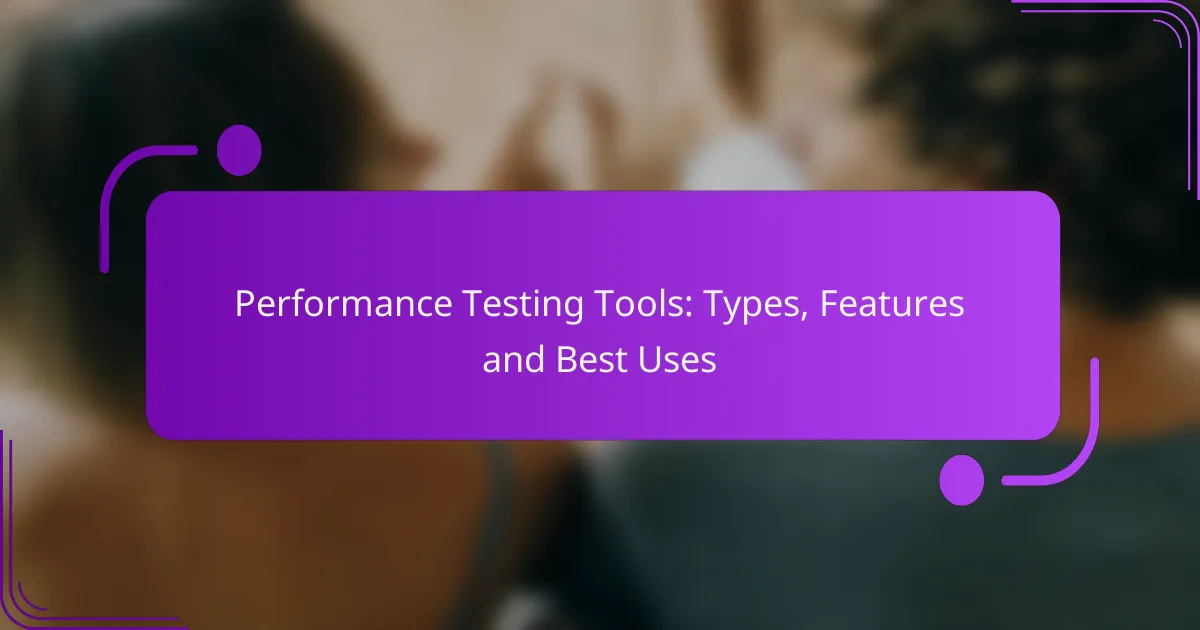Performance testing tools are essential for assessing how applications respond to varying load conditions, helping to identify bottlenecks and enhance scalability. By simulating real-world usage scenarios, these tools improve user experience and ensure system reliability. Selecting the right tool requires a clear understanding of project needs and compatibility with existing systems, as each type of performance test—such as load, stress, endurance, and spike testing—serves a unique purpose in evaluating system performance.

What are the best performance testing tools available?
The best performance testing tools are designed to evaluate how applications behave under various load conditions. They help identify bottlenecks, ensure scalability, and improve user experience by simulating real-world usage scenarios.
Apache JMeter
Apache JMeter is an open-source tool widely used for performance testing web applications. It supports various protocols, including HTTP, FTP, and JDBC, making it versatile for different testing needs.
JMeter allows users to create test plans with multiple threads, simulating concurrent users. It provides detailed reports and graphs, helping teams analyze performance metrics effectively. However, it may require some technical expertise to set up complex scenarios.
LoadRunner
LoadRunner is a comprehensive performance testing solution from Micro Focus, suitable for enterprise-level applications. It can simulate thousands of users and supports a wide range of protocols, making it ideal for large-scale testing.
LoadRunner offers advanced analytics and reporting features, which help in identifying performance bottlenecks. However, it can be costly, and organizations should weigh the investment against their specific testing requirements.
Gatling
Gatling is an open-source performance testing tool that focuses on ease of use and high performance. It is particularly known for its powerful scripting capabilities, allowing users to write tests in Scala.
Gatling provides real-time metrics and detailed reports, which can be beneficial for quick analysis. Its lightweight architecture makes it suitable for continuous integration environments, but it may have a steeper learning curve for those unfamiliar with Scala.
BlazeMeter
BlazeMeter is a cloud-based performance testing platform that integrates well with existing CI/CD pipelines. It supports various testing tools, including JMeter, making it a flexible choice for teams already using those tools.
With BlazeMeter, users can run tests at scale and analyze results in real-time. Its pricing model is based on usage, which can be cost-effective for smaller teams but may become expensive for larger projects with extensive testing needs.
NeoLoad
NeoLoad is a performance testing tool designed for web and mobile applications, focusing on user experience. It supports a wide range of technologies and provides robust analytics to help teams optimize performance.
NeoLoad allows for easy test creation and execution, making it accessible for teams with varying levels of expertise. Its licensing can be on the higher side, but the investment may be justified by its comprehensive features and support for agile development practices.

How to choose the right performance testing tool?
Choosing the right performance testing tool involves understanding your specific project needs, evaluating usability, and considering how well the tool integrates with your existing systems. A well-chosen tool can significantly enhance your testing efficiency and accuracy.
Consider project requirements
Start by identifying the specific requirements of your project, such as the type of application being tested, the expected user load, and the performance metrics that matter most. For instance, web applications may require load testing to handle thousands of concurrent users, while mobile apps might focus on response times under varying network conditions.
Additionally, consider the testing environment and whether the tool supports cloud-based or on-premises testing. This can affect scalability and cost, particularly if you anticipate fluctuating workloads.
Evaluate ease of use
Assessing the ease of use of a performance testing tool is crucial for ensuring that your team can effectively implement and utilize it. Look for tools with intuitive interfaces and comprehensive documentation, which can reduce the learning curve and speed up the testing process.
Consider tools that offer pre-built templates or scripts for common testing scenarios. This feature can save time and help teams focus on analysis rather than setup. A trial version can also provide insights into usability before committing to a purchase.
Assess integration capabilities
Integration capabilities are vital for a performance testing tool to work seamlessly with your existing development and testing environments. Ensure the tool can easily connect with CI/CD pipelines, issue tracking systems, and other development tools you use.
Check for compatibility with popular platforms and frameworks, as well as the ability to export results in formats that can be easily shared or analyzed. This will facilitate smoother collaboration across teams and enhance overall productivity.

What types of performance testing are there?
Performance testing encompasses various types that assess how a system behaves under different conditions. The main types include load testing, stress testing, endurance testing, and spike testing, each serving specific purposes and revealing different aspects of system performance.
Load testing
Load testing evaluates how a system performs under expected user loads. It simulates multiple users accessing the application simultaneously to determine if it can handle the anticipated volume without performance degradation. This type of testing helps identify bottlenecks and ensures the system meets performance requirements.
When conducting load testing, aim for a realistic user load that reflects peak usage scenarios. Tools like Apache JMeter or LoadRunner can be used to simulate these conditions effectively.
Stress testing
Stress testing pushes a system beyond its specified limits to determine how it behaves under extreme conditions. The goal is to identify the breaking point of the application and observe how it recovers from failure. This type of testing is crucial for understanding system resilience and stability.
During stress testing, gradually increase the load until the system fails. Monitor key metrics such as response time and resource utilization to gain insights into performance limits and recovery capabilities.
Endurance testing
Endurance testing, also known as soak testing, assesses how a system performs under a sustained load over an extended period. This type of testing is essential for identifying memory leaks and performance degradation that may occur over time. It ensures that the application can handle prolonged usage without issues.
For effective endurance testing, simulate a consistent load for several hours or days. Monitor system performance metrics continuously to detect any gradual decline in performance or resource exhaustion.
Spike testing
Spike testing involves subjecting a system to sudden and extreme increases in load to evaluate its reaction to abrupt changes. This type of testing is important for applications that may experience sudden spikes in user activity, such as during a promotional event or a product launch.
To conduct spike testing, rapidly increase the number of users accessing the system and observe how it handles the surge. Key metrics to monitor include response times and error rates, which will help identify how well the system can cope with unexpected traffic spikes.

What features should you look for in performance testing tools?
When selecting performance testing tools, prioritize features that enhance your ability to monitor, analyze, and optimize application performance. Key aspects include real-time analytics, scalability options, and support for various protocols to ensure comprehensive testing across different environments.
Real-time analytics
Real-time analytics allow you to monitor application performance as tests are conducted, providing immediate insights into system behavior. This feature helps identify bottlenecks or failures instantly, enabling quick adjustments to testing strategies.
Look for tools that offer dashboards displaying key performance indicators (KPIs) such as response times, throughput, and error rates. Effective real-time analytics can significantly reduce the time needed to diagnose issues, often cutting it down to mere seconds or minutes.
Scalability options
Scalability options are crucial for performance testing tools, as they determine how well a tool can handle increased loads. A good tool should support the ability to simulate thousands of users or transactions without compromising accuracy or performance.
Consider tools that allow for easy configuration of load scenarios, enabling you to test under various conditions. This flexibility can help you assess how your application performs under both normal and peak usage, which is essential for ensuring reliability.
Support for various protocols
Support for various protocols ensures that your performance testing tool can effectively evaluate diverse applications and services. Look for tools that can handle HTTP, HTTPS, WebSocket, and other protocols relevant to your technology stack.
This capability allows for comprehensive testing across different platforms, ensuring that all components of your application are assessed. Tools that support multiple protocols can save time and resources by providing a unified testing environment, reducing the need for multiple specialized tools.
